What does Jesse Owens’ experience tell us about race in the United States in the 1930s?
EDUCATOR OUTREACH
Race and Sports: Exposing the Hypocrisy of the 1936 Berlin Olympics
The 1936 Olympic Games were fraught with controversy. Berlin was chosen as the site for the Olympics before the Nazi party had risen to power, and the Nazi’s persecution of Jews sparked a widespread movement in the U.S. to boycott the Olympics. This movement pressured high-profile American athletes to join the boycott. To many Black athletes, the plea to boycott for humanitarian reasons seemed hypocritical due to the racial oppression they experienced in the U.S. through Jim Crow laws, a segregated military, and all-white professional sports leagues.
Jesse Owens was one of the many Black athletes who participated in the 1936 Berlin Olympics. He competed in the long jump (26 feet 5 ¼ inches), 100 m dash (10.3 seconds), 200 m dash (20.7 seconds), and ran the first leg of the 4x100 m relay (39.8 seconds). Owens took gold in all these events, breaking or matching world records in the process (Haire, 2005). Owens success at the games led him to be heralded as one of the greatest track athletes of all time.
As you read the following context and listen to curated excerpts from Jesse Owens’s oral history, consider what he is telling you about society and the treatment of Black Athletes in America.
American Public Response to Owens
The United States was in a state of hypocrisy in the 1930s. While they sent Black athletes to compete for them, they also denied them equal protection at home. Jim Crow Laws were laws created to intentionally keep Black and White citizens segregated. These laws that systemized racialized discrimination were prominent in the United States after the end of slavery and ensured that African American citizens were kept out of mainstream society (Edwards and Bennett Thompson, 2010, p.145). Americans, however, relied on Black athletes' ability to bring home gold medals at Olympic and other international tournaments. At national competitions, people came out in droves to watch these young athletes break world records and showcase their skills.
OH EXCERPT: “I remember my senior year we had our last track meet. This in my last meet running for East Tech and this was the Senate championship and we had twenty-thousand people to watch this last track meet. (. . .) First time in 1933 at Soldiers Field. We brought these four fellows with us. The four of us came. And we won the last national inter-scholastic championship they've ever, they held in this country. We took the title back to Cleveland. They had a parade for us, and the citizens were quite proud. This is our senior year. I went to summer school to graduate and then I went down to Ohio State.” Tape 1 Page 20 (click here for audio of excerpt)
Jesse Owens’ athletic ability was an asset to the American people and government. He was an accomplished athlete and his fans filled stadiums, hoping to see records broken. Even though he and other Black athletes dealt with discrimination, when world competitions like the Olympics occurred, America called on Black athletes to perform for the flag.
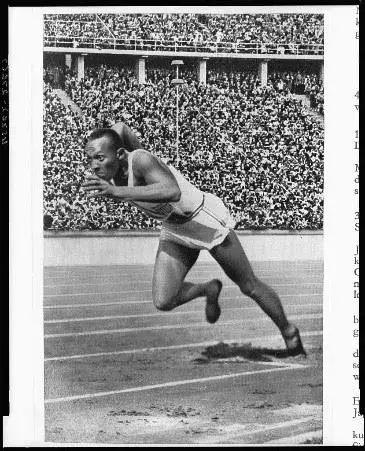
Jesse Owens mid race at the 1936 Berlin Olympics (DocsTeach 1936).
Qualifying for the Olympics
Before athletes were eligible to compete at the Olympics, they needed to make qualifying marks at pre-determined competitions. Most amateur athletes had to rank highly in their college conferences or Amateur Athletic Union (AAU) meets to participate.
OH EXCERPT: How athletes are chosen:
• BM - Now how are the Olympic contenders chosen?
• JO - Well they are chosen this way. All through the year, they these different meets. Now, then they come up to the finals. The finals are for two days and to qualify into the finals, either you have to place one, two, three, four in the national Collegiate track meet, the AAU track meet or your conference track meet. You know like every school has a conference involved in some conference and so these athletes that qualify in the conference meet and in the National Collegiates and or in the AAU are invited to the final try outs at Randall’s Island. Tape 1 Page 35
Owens competed at the Big Ten conference meet for his chance to qualify. Prior to competing, he sustained injuries to his back. Unable to walk on his own due to the pain, he managed to make it onto the field with assistance from teammates. Listen as Owens’ describes this experience and overcoming the pain to race towards victory. His success at the Big Ten Conference ensured he could compete in the 1936 Olympic team trials.
OH EXCERPT: Big Ten World Record (click here for audio of excerpt)
And then when he said on your mark and as I tried to get down on my mark, I felt this pain still in my back. And then when he said set, I came up waiting for the gun, I felt no pain when I came up. The gun went off. I ran the entire day without a pain anywhere. Everything was timed right. My timing was right. I was off with the gun. My knees were working perfectly. My arms were synchronized with my legs. The body position that we worked so hard for was there. The movement of the head was none which was there. You kept it stationary as if you had a glass of water there. And so, I finished the hundred and we ran it in nine four. Then we didn't take time to put your sweatsuit on to work because the broad jump was in progress. Going over to the broad jump and reporting and waiting for a couple of fellows to jump. It was my turn to jump. I asked to have the handkerchief to be placed on the twenty-six feet two and half inches which was the world's record at that time. I took this one jump; I got up into the air and I sailed past this two and 40 half mark and when it was measured it was twenty six feet eight and quarter inches. Tape 2 Page 40-41
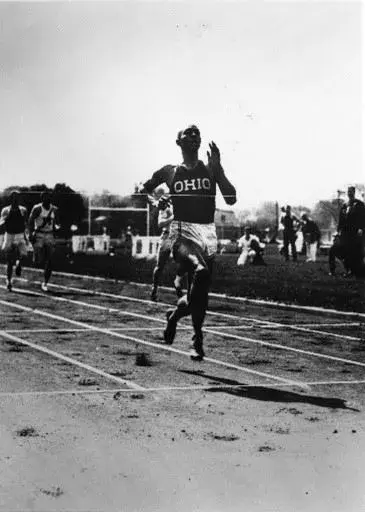
Jesse Owens crossing the finish line after running the 220-yard Dash in the Big Ten Meet at Gerry Field Stadium in 1935. (University of Michigan, Athletic Department, 1935)
After qualifying, Owens competed at the Olympic Trials at Randall’s Island in New York to earn a spot on the team. All the men who qualified competed here, fighting for a chance to represent their country in Berlin. Unlike a college meet, Owens competed against the best runners in America for his chance to compete in Berlin. In the trials, he won all three of his individual events at the trails, beating his teammates Ralph Metcalfe, Frank Wykoff, and Foy Draper (History.com, 2021). After Owens made the Olympic team, however, questions began to arise about whether America would compete.
1936 Olympics
Nazi Germany had set laws discriminating against anyone not of the Aryan race. In Germany, the term “Aryan race” was used to separate those who were and were not part of German society. Aryan was used to classify people who were a part of this society, placing them above all others in the eye of German elites (United States Holocaust Memorial Museum, 2020). Although this classification allowed Nazis to discriminate against many people, they heavily persecuted German Jews. Due to this, some countries, including America, believed sending athletes would showcase support for Hitler and his regime. Black Americans looked on in disbelief as U.S. leadership condemned Hitler’s words, recognizing the irony of what their leaders were saying compared to their lived experiences.
The International Olympic Committee (IOC) heard cries for the Olympics to be moved and stepped in to attempt to create a solution. The IOC sent Avery Brundage to Germany (Kass, 1976, 225). Brundage was meant to ensure no discrimination against athletes occurred leading up to the Olympics. As a result of this Germany was forced to accept Jewish athletes as contenders for the games.
OH EXCEPRT: “A number of things had been said in the papers and throughout the world that many of the countries would not go because of his policies that he had spoken of and things that appeared in the paper. And after two days of real anxious waiting, we finally got the word that the American team was going to go regardless.” Tape 3 Page 57. (click here for audio of excerpt)
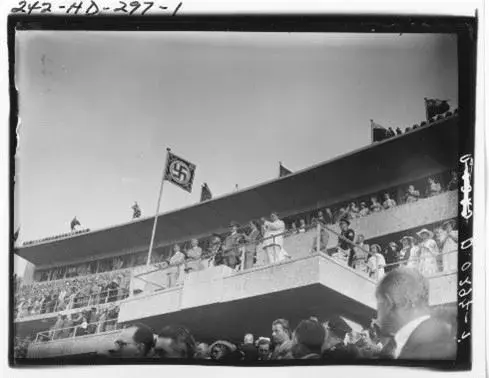
Adolf Hitler watches the Berlin Olympics from his box inside the stadium (DocsTeach, 1936)
Even though the German government held discriminatory ideas about non-Aryan races, German citizens lined the streets to see Olympic athletes and cheer them on. Listen as Jesse Owens describes the enthusiastic welcome received upon his arrival in Germany.
OH EXCERPT: “The German people were wonderful. They had thousands to greet us as we came into the station. And they cheered and cheered, and they were calling out your name as you sat upon top of a bus and rode to the city hall and people wanted to get a look at you.” Tape 2 Page 53 (click here for audio of excerpt)
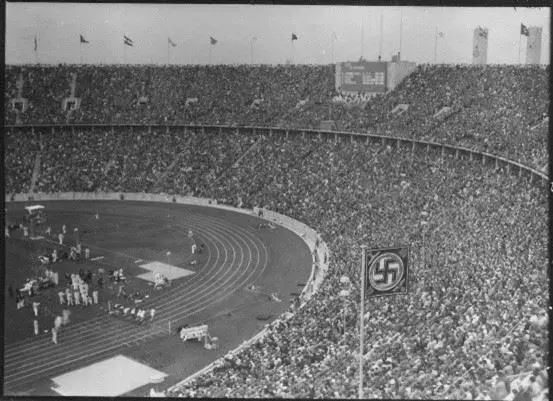
Berlin Olympic Track Stadium filled with attendees to the games. (DocsTeach, 1936)
With the stadiums filled with bystanders to the games, Owens talks about the pressure he felt to compete at his best.
OH EXCERPT: Yes, I do believe it became more serious at the time. Your responsibilities before was in the realm of your family and in people and the few people that believed. Now this is something else. This is something else, this is something where you become worldwide. Where people begin to talk about it. Now you have an obligation to fulfill. People coming to see you perform and you've got to give them the best that you have within you on that particular day. And then you begin to realize that now this I've got to be a little bit more careful of. I've got to be ready on this particular day. Tape 2 Page 42
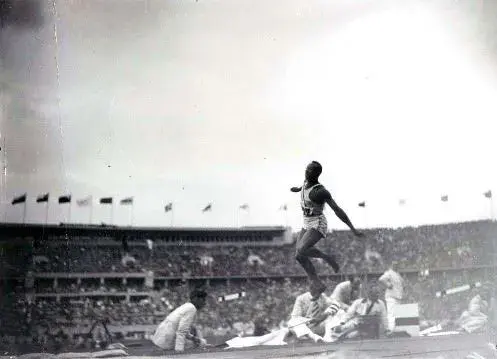
Owens midair during a long(broad) jump attempt at the Berlin Olympics (DocsTeach, 1936)
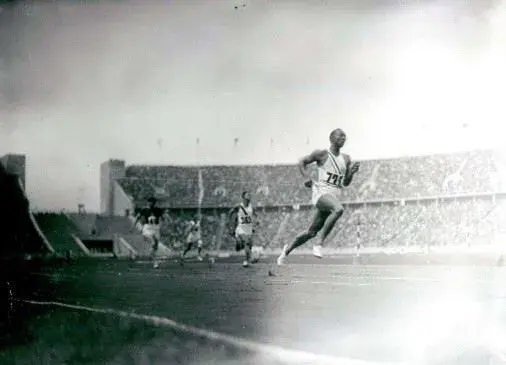
Owens racing at the 1936 Berlin Olympics. It is unknown which race this is as of October 2023. (DocsTeach, 1936)
Regardless of the pressures Owens faced, his performance in 1936 was legendary. He earned the highest honors available to athletes. He won gold and broke World Records in the four events he competed in. While there have been other track athletes to win four gold medals in a single game, they were distance runners. Earning four golds in the short sprints had never been done before, making Jesse Owens the first man in history to do so (Tape 3 Page 64).
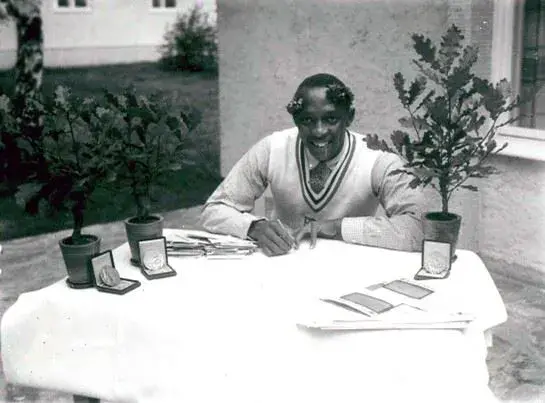
(DocsTeach, 1936)
Jesse Owens took four gold medals home as a result of his performance in Berlin. Even though he had competed, Owens found it difficult to realize his feat in Berlin. Listen as he describes his thoughts on his Berlin successes.
OH Excerpt:
• BM - Were you prepared for that much success, or were you?
• JO - Well, this is the question. A no. Because coming from humble beginnings and not having many things in life, one that finds himself thrown into the flood light of all of the things and of all of the possibilities, I don't think that anyone is ever prepared for that sort of thing. You never know that things like that would happen to you. Tape 3 Page 64
Who Snubbed Jesse Owens?
Following the 200m dash, Owens and other athletes were returning to the field to broad jump. Hitler was congratulating athletes for their performances, however, when he saw Owens, he turned away and returned to the stands. Many media outlets at the time referred to this as Hitler’s snub of Jesse Owens, however, the failure of US President Franklin D. Roosevelt to interact with Black athletes after the Olympics had a larger impact on Owens. Following the Olympics, athletes were traditionally sent to the White House to receive praise from the president, as a form of thanking them for upholding American athleticism; however, Black athletes were not invited to the gathering in 1936. As Owens noted, “Hitler didn’t snub me. It was (Roosevelt) who snubbed me. The president didn’t even send me a telegram.” (Ramsey, 2021).
While this may seem odd today, President Roosevelt was in an election year and knew he could lose the coming election. Roosevelt’s reliance on Southern-White voters caused him to decide to honor White Olympic athletes while simultaneously ignoring Black American athletes who had won. While Roosevelt ultimately decided to honor White athletes only, there was correspondences asking him to honor both athletes equally. Read the letters below from Pastor Ernest Hall and H.R. O’Keefe who both wrote to the President, imploring him to ignore race when he honored the athletes.
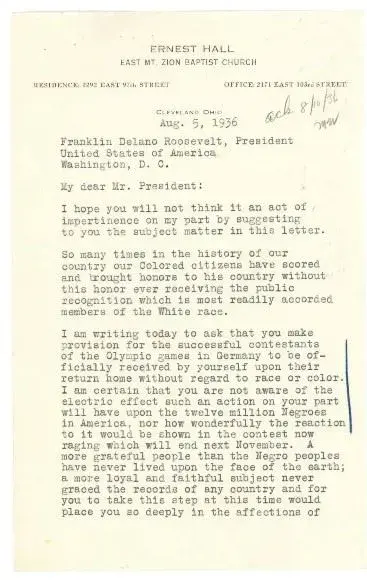
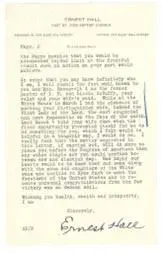
E. Hall. personal communications, August 5, 1936.
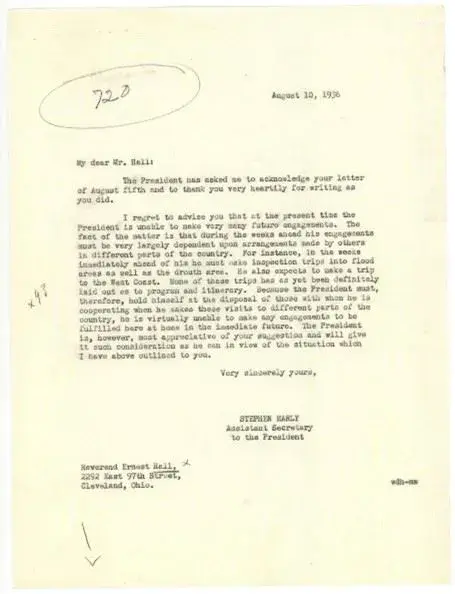
S. Early, personal communications, August 10, 1936.
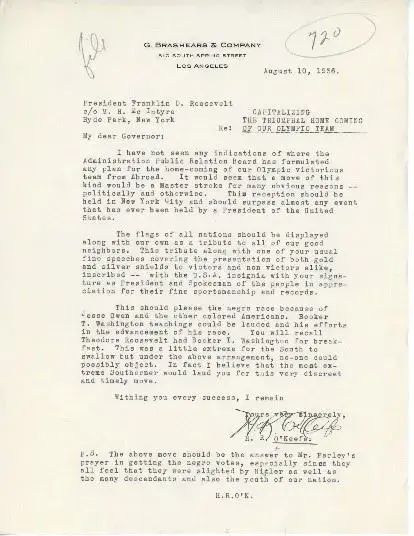
H.R. O’Keefe, personal communication, August 10, 1936.
Regardless of those advocating for a united recognition, President Roosevelt decided to honor only the White athletes, thus snubbing Jesse Owens and all the other Black Olympians from Berlin.
Reception at Home
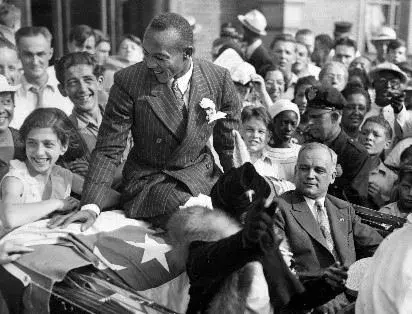
Jesse Owens upon his return to Cleveland, Ohio, celebrating his success in Berlin. (Central Press Association 1936)
Upon their return, Olympians were swarmed with support from friends and families, congratulations from fans, and endorsement deals from major brands. While each athlete was given support, Black athletes did not receive brand deals. Companies believed Black athletes would not sell as many products as White athletes, so they were often left off cereal boxes and out of advertising promotions. Even though they were praised for their contributions to the American flag, Black athletes were cast to the outskirts of society upon their return.
OH EXCERPT: Endorsement
• BM - Were you always wise as what to endorse or whom to endorse?
• JO - No, well, because at that time we were very limited into the field of endorsement, because of the southern part of our country at that time. It did not advocate the Negros's picture on any bread or any other national brand of advertisement. We could not get it at that time. And so there you were limited to the kind of advertising that you could endorse, you see.
• BM - What sort of things did you endorse?
• JO - Well, we endorsed a local situation, we endorsed bread, we endorsed Wheaties on a local basis. We would endorse a, perhaps, toothpaste on a local basis. Tape 3 Page 66
Presidential Recognitions
In 1976, Jesse Owens was honored for his performance in Berlin by President Gerald Ford. Ford presented Owens with the Presidential Medal of Freedom, the highest honor a civilian can receive.
Ford spoke to Owens’s performance at the games, stating he proved that athletic ability knows no race or politics.
“In 1936, when Jesse Owens, or when Adolph Hitler was trying to turn the Games into a spectacle that would glorify racist dogma of the Nazi State, there was a strong movement in the United States against our participation in the Games. As it turned out, U.S. participation in those Olympics provided a sharp rebuke of Hitler's racist rubbish. Five black American athletes won eight gold medals in track and field. One American athlete in particular proved that excellence knows no racial or political limits. That man is Jesse Owens (Ford 1976).”
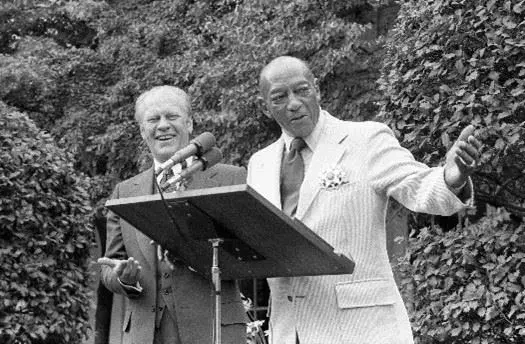 Jesse Owens receives the Presidential Medal of Freedom from President Gerald Ford. (National Archives and Records Administration, 1976)
Jesse Owens receives the Presidential Medal of Freedom from President Gerald Ford. (National Archives and Records Administration, 1976)
In 2016, President Barack Obama called for the eighteen Black Olympians from the 1936 games, Tommie Smith and John Carlos, and the 2016 U.S. Olympic and Paralympic teams to be recognized (Associated Press, 2016). In his speech, President Obama recounted Owens’s performance, believing it spoke not only of him, but about Americans and Black Americans as a whole (Ramsey 2021). As Owens’s experience demonstrated, traveling to Nazi Germany showcased that Black Americans were a force both in America and abroad. This recognition came posthumously, as Owens had passed away in 1980. As you watch, consider how Obama speaks of Owens’ performances, and think back to Ford’s speech to notice similarities and differences.
Michael McIntee 2016.
{{video=https://www.youtube.com/watch?v=ji-9PimDLRQ}}
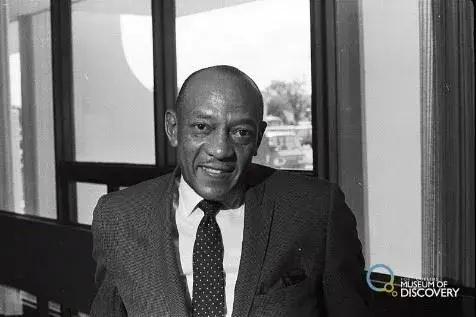 Jesse Owens at the Colorado State University. (Fort Collins Coloradoan, 1968)
Jesse Owens at the Colorado State University. (Fort Collins Coloradoan, 1968)
Resources for Teachers
Listening to the Audio
You can listen to Jesse Owens’s oral history on the Abraham Lincoln Presidential Library and Museum’s Chronicling Illinois Site. The nearly six-hour audio is broken into five tapes. Tapes 1-4 include Jesse Owens being interviewed by Barbara Moro. Tape 5 is an interview with Minnie Ruth Solomon.
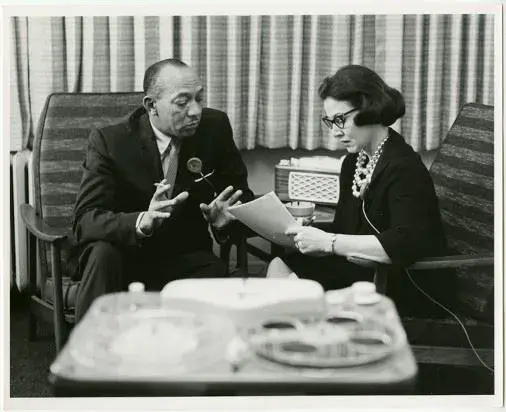 Owens interviewed by Barbara Moro.
Owens interviewed by Barbara Moro.
Library of Congress
The Library of Congress (LOC) offers brief teaching guides and primary source sets about an array of topics, including Jesse Owens and his involvement with the NAACP. This guide includes primary sources. To learn more, see The NAACP: A Century in the Fight for Freedom.
Docs Teach
Similar to the Library of Congress, the National Archives And Records Administration (NARA) offers free teaching resources on a variety of subjects. Searching "Jesse Owens" wields a range of primary sources and tips on effective classroom use.
References
Associated Press. (2016, September 29). Relatives of Jesse Owens and Other 936 Black Olympians Finally Visit White House. NBC News. https://www.nbcnews.com/news/nbcblk/relatives-jesse-owens-other-1936-black-olympians-finally-visit-white-n657101
Bell, D. (2012, July 27). An Olympian Effort: The Story of Jesse Owens in Library of Congress Primary Sources. Library of Congress Blogs. https://blogs.loc.gov/teachers/2012/07/an-olympian-effort-the-story-of-jesse-owens-in-library-of-congress-primary-sources/
Central Press Association. (1936, August 25). Jesse Owens, 1936. [Photograph]. https://cplorg.contentdm.oclc.org/digital/collection/p4014coll18/id/4788
DocsTeach. (1936). 1936 Olympic Stadium in Berlin, Germany. [Photograph]. https://www.docsteach.org/documents/document/1936-olympic-stadium-berlin-germany
DocsTeach. (1936, August). Jesse Owens at the 1936 Olympics in Berlin, Germany. [Photograph]. https://www.docsteach.org/documents/document/owens-long-jump
DocsTeach. (1936, August). Jesse Owens at the 1936 Olympics in Berlin, Germany. [Photograph]. https://www.docsteach.org/documents/document/owens-medals
DocsTeach. (1936, August). Jesse Owens at the 1936 Olympics in Berlin, Germany. [Photograph]. https://www.docsteach.org/documents/document/owens-running-olympics
DocsTeach. (1936). Olympian Jesse Owens. [Photograph]. https://www.docsteach.org/documents/document/jesse-owens
DocsTeach. (1936, August), Hitler Watching the Olympic Games in Berlin, Germany. [Photograph]. https://www.docsteach.org/documents/document/hitler-olympics-berlin
Edwards, F.L. and G. Bennet Thompson, AIA. (2010, January). The Legal Creation of Raced Space: The Subtle and Ongoing Discrimination Created Through Jim Crow Laws. Berkeley Journal of African-American Law & Policy, 12(1), 145-167. https://doi.org/10.15779/Z38XC8T
Ford, G. (1976, August 5) “Exchange of Remarks Between the President and Jesse Owens: 1936 Olympic Gold Medal Winner” [speech]. https://catalog.archives.gov/id/7345229
Fort Collins Coloradoan. (1968, August 20). Jesse Owens. https://fchc.contentdm.oclc.org/digital/collection/ph/id/10257
Haire, K. (2005, February). Jesse Owens: A Lasting Legend. The Ohio State University. https://library.osu.edu/site/jesseowens/1936-olympics/
Hall, E. personal communications, August 5, 1936.
History.com Editors. (2021, August 06). Jesse Owens wins 4th gold medal. History. https://www.history.com/this-day-in-history/owens-wins-4th-gold-medal
Jesse Owens. (UNKNOWN). Olympics. Retrieved October 19, 2023, from https://olympics.com/en/athletes/jesse-owens
Illinois State historical Library. (1961). Jesse Owens [Oral History]. https://www.chroniclingillinois.org/items/show/31886
Kass, D.A. (1976). The Issue of Racism at the 1936 Olympics. Journal of Sport History, 3(3), 223-235. https://www.jstor.org/stable/43609664
Michael McIntee. (2016, September 26). Obama Rights Historical Racial wrong for Olympic Heroes [Video]. YouTube. https://www.youtube.com/watch?v=ji-9PimDLRQ
National Archives and Records Administration. (1976, August 5). Photograph of Gerald Ford and Jesse Owens During the Presentation of the Medal of Freedom in the East Garden of the White House. [Photograph]. https://catalog.archives.gov/id/7062576
O’Keefe, H.R., personal communication, August 10, 1936.
Perry, R.L. (1939, Aril 22). Jesse Owens. https://www.loc.gov/resource/wpalh0.07011006/?sp=1&st=image&r=-0.695,0.101,2.39,0.614,0
Ramsey, D. (2021, March 29). Jesse Owens Rose Triumphant Over Hitler . . . and Roosevelt. The Gazette. https://gazette.com/news/jesse-owens-rose-triumphant-over-hitler-and-roosevelt-david-ramsey/article_9e3c53d0-54c0-11ea-b136-c73abbf5bd68.html
Retro Report. (2020, June 23). Athletes vs. Injustice: Protests in Sports [Video]. YouTube. https://www.youtube.com/watch?v=JEVT87x_e04
Saito, M. (2011, July 27). Jesse Owens’ Legacy, and Hitler’s Oak Trees. NPR. https://www.npr.org/2011/07/27/138590488/jesse-owens-legacy-and-hitlers-oak-trees
United States Holocaust Memorial Museum. (2020, September 23). Holocaust Encyclopedia. https://encyclopedia.ushmm.org/content/en/article/aryan-1
University of Michigan, Athletic Department. (1935, May 25). Jesse Owens, Ohio State, 1935 Bit Ten Track Meet at Ferry Field, 220-yard Dash. [Photograph]. https://quod.lib.umich.edu/cgi/i/image/image-idx?id=S-BHL-X-BL012695%5DBL012695